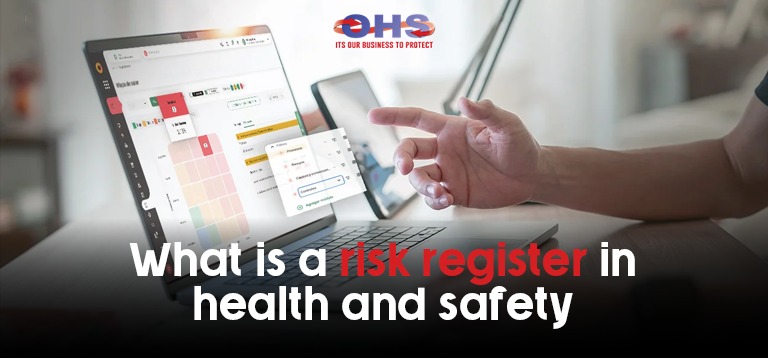In the UAE, where workplaces are changing quickly, it’s more important than ever to keep employees safe. A risk register is an important document that helps find, assess, and deal with issues related to health and safety at work. At corporateohs, we stress that having a good risk register not only keeps workers safe but also helps businesses follow the strict rules set by the UAE.
Understanding a Risk Register
Definition of a Risk Register
A risk register is a way for businesses to keep track of possible dangers, assess how bad and likely they are, and come up with ways to lessen or get rid of them. It is a living document that changes all the time to reflect new risks and better safety rules.
Importance of Health and Safety
A risk registry is very important in the UAE, where building, manufacturing, and oil and gas are common. At corporateohs, taking steps to prevent accidents, make sure rules are followed, and promote a culture of safety awareness is a good idea.
Legal Requirements for Risk Registers in the UAE
UAE Federal Law and Compliance
According to UAE Federal Law No. 8 of 1980, employers must keep the workplace safe. This duty includes finding dangers at work and managing risks in a way that works. Corporateohs says that a well-documented risk register helps organisations show that they are following the rules during inspections and audits.
Industry-Specific Regulations
Specific sectors, including construction and oil & gas, must comply with additional guidelines from regulatory bodies such as the Abu Dhabi Occupational Safety and Health Centre (OSHAD) and Dubai Municipality. CorporateOHS supports the development of detailed, industry-specific risk registers to meet these expectations.
Key Components of a Risk Register
- Identified Hazards
Clearly listing all potential hazards physical, chemical, biological, ergonomic, and psychological is essential for creating an effective risk register.
- Risk Assessment
Each hazard should be evaluated based on its potential impact and likelihood. This prioritization enables businesses to allocate resources effectively to manage critical risks first.
- Control Measures
The register must outline detailed control measures such as personal protective equipment (PPE), training, or engineering solutions to mitigate risks effectively.
- Risk Owner and Accountability
Assigning ownership to specific individuals ensures accountability, fostering a culture where health and safety are everyone’s responsibility.
- Monitoring and Review
Regular reviews of the risk register ensure continuous improvement and adapt to evolving hazards or operational changes. CorporateOHS recommends quarterly reviews at a minimum.
How to Create a Risk Register in the UAE
Step-by-Step Guide
- Hazard Identification
Gather insights from employees, supervisors, and industry guidelines to list possible workplace hazards.
- Risk Assessment
Evaluate and prioritize risks using a standardized matrix to determine their severity and likelihood.
- Implementing Controls
Select and document effective measures to control, reduce, or eliminate identified risks.
- Assigning Responsibilities
Clearly define and communicate who is responsible for managing each risk.
- Regular Review
Schedule periodic updates to the risk register to reflect changes in workplace conditions, regulations, or industry standards.
CorporateOHS offers consulting services to guide UAE businesses through each of these steps efficiently.
5 Proven Benefits of Using a Risk Register
- Improved Workplace Safety
Regular hazard identification and management significantly reduce accidents and improve overall safety.\
- Enhanced Legal Compliance
Consistent use of a risk register ensures compliance with UAE health and safety laws, reducing potential legal liabilities.
- Reduced Financial Loss
Proactively managing risks prevents costly incidents, insurance claims, and operational disruptions.
- Boosted Employee Morale
Employees who feel their safety is valued demonstrate higher morale, productivity, and engagement.
- Better Crisis Management
Preparedness and clearly defined procedures within the risk register equip businesses to respond swiftly during emergencies.
Common Mistakes to Avoid in Risk Registers
- Failure to regularly update
- Vague descriptions of hazards and controls
- Inadequate training of responsible personnel
- Poor communication of identified risks
At corporateohs, we help organizations identify and avoid these common mistakes through expert audits and tailored solutions.
Best Practices for Maintaining a Risk Register
- Regular audits and reviews
- Clear and simple language for accessibility
- Engaging employees at all levels in updates
- Utilizing digital software tools to manage and automate updates
CorporateOHs also provides digital solutions and training to support these best practices.
Conclusion
Businesses in the UAE need to develop and keep up a good risk register for health and safety. At corporateohs, it makes the workplace safer, makes sure the law is followed, enhances morale, and helps reduce risks in a big way. Companies can get a lot of safety and operational benefits by using best practices and avoiding frequent mistakes.
Frequently Asked Questions
What is the main purpose of a risk register?
The main purpose of a risk register is to systematically identify, assess, and manage risks to enhance workplace safety and compliance.
Who should manage a risk register?
Typically, a designated health and safety officer or manager should manage the risk register, although responsibility should be shared across all departments.
How often should a risk register be updated?
A risk register should be reviewed and updated quarterly or whenever significant changes occur in the workplace environment or operations.
Is a risk register legally required in the UAE?
While not explicitly mandated, a detailed risk register strongly supports legal compliance under UAE Federal Law and industry-specific regulations.
Can risk registers prevent workplace accidents?
Yes, properly maintained risk registers significantly reduce the likelihood of workplace accidents by ensuring hazards are continuously managed.
What software is recommended for risk registers?
Recommended software includes solutions like EcoOnline, Intelex, and SafetyCulture, known for their ease of use and comprehensive features.

